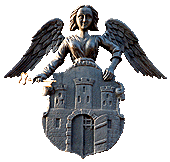Angel of Toruń
Toruń under the care of the angel
The angel is an element that distinguishes the crest of Toruń from among the heraldic signs of other Polish cities. The profile of the angel appeared in the crest of Toruń after the end of the thirteen-year war in the 15th century and has survived to our times. Thanks to this, the angel is one of the most important symbols of Toruń.
The figure of the angel was not used in the municipal signs of Toruń from the beginning of the city, i.e. from the moment of the foundation of Toruń by the Teutonic Knights in 1233. The oldest seal of the city, inspired by the presence of the Teutonic Knights in Toruń, (called ‘Marian’, ‘with Madonna’ or ‘great’) represented two round donjons with a gate in the middle. In the arc of the gate the Virgin Mary with infant Jesus sat on a throne. The Madonna from the seal was dressed in a veil, she had a crown from three lilies on her head, and a locket hung on her breast. This seal served the marking of important documents. Its imprint was made on e.g. the famous Peace Treaty signed in Toruń in 1411 after the battle of Grunwald, but also on the document that confirmed the annexation of Toruń by the Prussian Union in 1440. The last time it was used, however, was in the 20th century – it sealed the document of the conferment Marshal Edward Rydz-Śmigły of the honorary citizenship of Toruń.
Toruń broke administrative relations with the Teutonic Knights in 1454. The homage paid by the townsmen of the Chełmno Land in Toruń to King Kazimierz Jagiellończyk marked an actual incorporation of the city into the borders of the Republic of Poland. The incorporation and the following thirteen-year war decided about the necessity of the usage of a new crest and new seals.
The first document with the new seal was issued in Toruń in January 1470, when, for the first time, appeared the motif of the Toruń angel supporting the earlier used escutcheon which represented the three municipal towers with a half-open gate in the middle. The introduction of the angel into the coat of arms of Toruń in the context of the long lasting and the very war which was a burden for the city can be explained by the will of the inhabitants to appeal to divine help. Towards the end of the 15th century, a new version of the seal was introduced, on which the angel was presented in a slightly changed position: kneeling and slightly leaning over the escutcheon it held. The angel in this version of the seal remained for over 300 years.
The angel of Toruń appeared also on the seals of the Magistrate of the main City of Toruń in the period of the Warsaw Duchy, and also during the partitions in the 19th century. The angel guarded the city also in the period between the two world wars. In 1936 the Minister of Internal Affairs approved of the crest of Toruń on which „the escutcheon is held by a kneeling angel in a blue gown with silvery wings. The hair of the angel is black, the face and the hand of the natural colour”. The angel from the Toruń crest was removed, however, after World War II. Fortunately, it came back to its place at the end of December, 1991.
Today the angel of Toruń guards, as in the past, the whole of Toruń. Its image is present especially in the Old Town of Toruń. Among other places, it is present on the gable of the building in the Caesar Arc, on the facade of the Arthur’s Mansion, over the gate of the Old Town Hall or in the stained-glass window over the entry to the main building of the Office of the City of Toruń.



